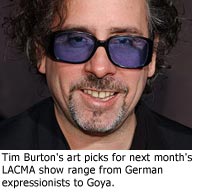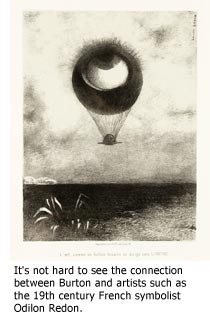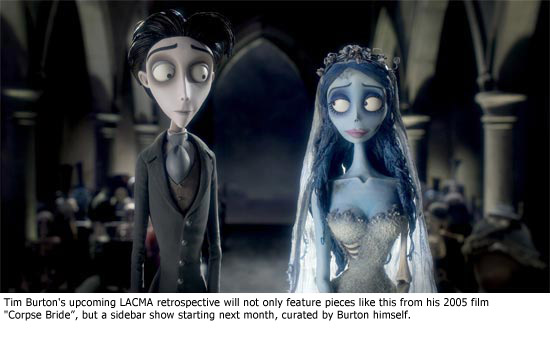Tim Burton’s art—and artists—at LACMA
June 1, 2011
If you can’t wait for the Los Angeles County Museum of Art’s upcoming Tim Burton retrospective, just remember: Before there was “Edward Scissorhands” or “The Nightmare Before Christmas“, there was the French symbolist Odilon Redon.
Redon may not be as familiar as the director whose show opens May 29 at LACMA. But a special parallel exhibition there opening April 16 will confirm the suspicions of any art lover who ever saw a connection between the two. Entitled “Burton Selects,” the show was guest curated by Burton himself from the museum’s permanent collection and offers a glimpse of the inspiration behind his goth-whimsical point of view.
 “It’s art that Tim Burton responds to visually,” says Britt Salvesen, the LACMA curator who is organizing both “Burton Selects” and Burton’s much larger main show, which drew record crowds when it opened last year at the Museum of Modern Art in New York.
“It’s art that Tim Burton responds to visually,” says Britt Salvesen, the LACMA curator who is organizing both “Burton Selects” and Burton’s much larger main show, which drew record crowds when it opened last year at the Museum of Modern Art in New York.
Running through November 13 at LACMA’s Rifkind Gallery, the sidebar show will feature 38 prints and drawings picked by Burton from a long list of art already housed at LACMA. (Check out a gallery of Burton’s art, and some of his art selections, below.)
“It’s an eclectic range of things,” Salvesen says. “You can see motifs—skeletons, figures transforming from one thing into another—that transition into his own work.”
Francisco Goya’s The Sleep of Reason Produces Monsters will be there, Salvesen says, as will important pieces from the 1920s by German artists Otto Dix and George Grosz. Burton made special mention, she says, of Redon’s “The Eye”, “Like A Strange Balloon”, “Mounts Toward Infinity”, which Salvesen calls “a great image,” and the museum was glad to supply it. More than 25 artists are represented, she adds, ranging from a huge poster for the 1931 Fritz Lang thriller “M” to tiny, 4-inch-tall caricatures by the 17th century baroque printmaker Jacques Callot.
“He seemed to be drawn most to work from the late 19th and early 20th century, which wasn’t entirely surprising. I knew he had an affinity for German Expressionism, of which LACMA has one of the world’s best collections,” Salvesen says.
Although the Burton retrospective, which features more than 700 pieces of his own art, has already traveled to Melbourne and Toronto, “Burton Selects” is unique to LACMA, Salvesen added. “We’re the only venue that’s an encyclopedic museum, rather than just a museum of modern art or the moving image.”
The show also will help bridge the gap between the fine art more commonly associated with institutions like LACMA and the work of someone like Burton, whose professional training was as an animator at CalArts and who is perceived more as a purveyor of popular culture. “This is really a way to tie him into the broader museum context,” Salvesen says.
Burton is among an increasing number of Hollywood figures whose art has recently crossed over into museums, which have benefitted from the chance to attract more mainstream art lovers, but faced questions about the potential for the artist’s celebrity to trump the importance of the art works.
Last year, the Museum of Contemporary Art featured a survey of Dennis Hopper’s photography and paintings curated by the painter-director Julian Schnabel, and the Max Ernst Museum in Germany presented 150 paintings, drawings and lithographs by the director David Lynch.
Burton’s May show will feature more than 700 individual works from Burton’s own archives and those of his collaborators, including paintings, photographs, film and video. Running through Halloween at LACMA’s new Lynda and Stewart Resnick Exhibition Pavilion, it will include a giant topiary deer from the 1990 film “Edward Scissorhands”, a 21-foot-tall creature called “Balloon Boy” and a special room with a yet-to-be-announced installation by Burton.
Reviews of the New York show complained about the cramped quarters at MOMA. But LACMA is expected to easily accommodate its three sections—“Surviving Burbank,” “Beautifying Burbank” and “Beyond Burbank”—which were named for the community where Burton grew up.
LACMA also will present screenings of all Burton’s feature films in its Bing Theater during the run of the exhibition. And the director is expected to make an appearance, though it will be brief because Burton still has his day job: He’ll be shooting a new film version of “Dark Shadows“, the gothic soap from the 1970s.
Salvesen says the show “could be loosely compared to an exhibition we did at LACMA about the films of Salvador Dali—Dali did come to Hollywood for an intriguing period—and that project sort of gave us some experience with this kind of show. We’ll be looking at similar projects in the future. One in the works for 2013 is the avant-garde filmmaker Hans Richter. It’ll be a little bit different from Tim Burton, but it will bring film and experimentation into our galleries.”
Tickets to the main show go on sale May 2, but LACMA members get priority ticketing and admission, and can make reservations starting March 30. The museum also is offering new members two free tickets if they join today.
Here’s a gallery of Tim Burton’s art and some of his LACMA picks:
Posted 3/22/11

























 405 bridge work causes a stink
405 bridge work causes a stink